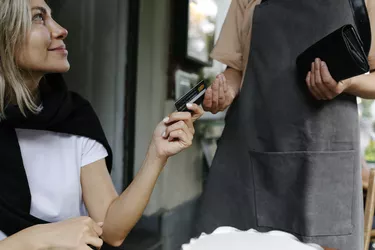
You should always factor in gratuity (the tip you'll pay your server) into your final bill when dining out. In many parts of the United States, servers receive less than minimum wage from the restaurants that employ them; the tips that a server receives are supposed to make up for the difference. A restaurant server may therefore have a base pay of only $2.13 an hour, so it's important to tip properly any time you dine out. You can tip with a debit card in the same way you would tip with a credit card; a restaurant will treat your debit card as credit when they swipe it for payment.
Basics of Tipping
Video of the Day
Tips may be left in cash on the table when you depart or, if you're paying by debit or credit card, added as a line item on your receipt. When your server brings back your receipt, you'll have the chance to write down the tip amount before signing.
Video of the Day
At the close of your meal, your server will bring a bill and accept your debit or credit card as a method of payment. (In some establishments, you may take your bill and card to the register at the front of the restaurant in order to pay.) The server then will take the card to process payment and return with two copies of the receipt, one for the restaurant to keep and one for the customer's personal records. Typically, these are marked as merchant copies and customer copies. The merchant copy of the receipt is the one where you'll note the tip and sign.
The receipt will include the total cost of your meal. If the restaurant accepts tips for servers, an empty line will appear beneath the cost of your food. This is where you will write the tip. On the line below that, you'll total the cost of the food and the tip, then sign.
Tipping With a Credit or Debit Card
The standard tip in restaurant service is 20 percent of the total pre-tax cost of the meal – although diners may choose to tip at higher percentages for exceptional service. One simple way to calculate the tip is to move the decimal place on the total cost one point to the left (to get 10 percent of the total), then double that number. Many restaurants now automatically calculate tip amounts at 15, 20 and 25 percent, and they include those numbers at the bottom of the receipt for the customer's convenience.
When you have written down the tip, add the amount of the gratuity to the cost of the food and write that total on the line below where you've written the tip. If you make a mistake and have to scratch out a number, be sure to initial the new number when you write it back in. Sign on the signature line and leave the merchant copy of the receipt on the table. This process will be the same whether you are using a debit or credit card.
How Does a Server Get Their Tip?
According to Chase, whereas restaurant servers immediately have access to a cash tip, a tip paid by credit or debit card is typically processed through the restaurant's payroll. Therefore, it will take longer to reach the server than a cash tip might. If you want to ensure that your server gets their tip quickly, a cash tip may be a better option.
Another point you should consider when dining out is that debit card transactions leave you at slightly greater financial risk in the event that your card information is stolen during the payment process. The Privacy Rights Clearinghouse notes that because debit cards draw directly from your bank account, just as a check does, a fraudulent debit card transaction puts your money at slightly greater risk than an equivalent credit card transaction.